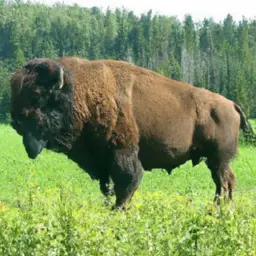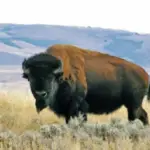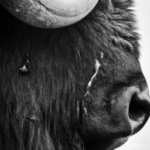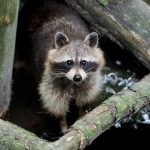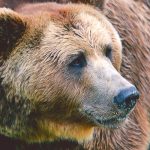Current Status of Wood Bison
Current Population Estimate
The current population estimate for Wood Bison is around 10,000 individuals. This is an encouraging increase compared to their lowest recorded population of only a few hundred individuals in the mid-20th century. The efforts of conservation organizations and reintroduction programs have played a significant role in the conservation of this species.
Locations of Wood Bison Populations
Wood Bison populations can be found in a few key locations, mainly in Alaska, Northwestern Canada, and national parks across the United States. Some of the largest populations can be found in Alaska’s Yukon-Charley Rivers National Preserve and Canada’s Wood Buffalo National Park. These protected areas have provided vital habitat and protection for Wood Bison populations.
Understanding Wood Bison
Wood Bison, also known as the American bison or Bison bison athabascae, are majestic creatures that once roamed the vast landscapes of North America. These massive mammals, characterized by their iconic hump and massive head, have captivated our imagination for centuries. Today, understanding Wood Bison and their importance in our ecosystem is crucial for their conservation and survival.
Definition of Wood Bison
Wood Bison are a subspecies of the American bison. They are the largest land-dwelling mammals in North America, with males weighing up to 2,000 pounds and standing over six feet tall at the shoulder. They are herbivores, predominantly feeding on grasses and sedges. Wood Bison have distinctive features such as a muscular build, a shaggy coat, and a large hump of muscle above their shoulders.
Historical Distribution of Wood Bison
Wood Bison once had a vast range extending from Alaska and Northwestern Canada down to the Great Plains of the United States. They thrived in diverse habitats, including forests, grasslands, and wetlands. However, due to centuries of hunting and habitat loss, their historical distribution became fragmented, leading to a severe decline in their population.
Recovery Efforts of Wood Bison
Key Organizations involved in conservation
Several organizations have been crucial in the conservation efforts of Wood Bison. The Wildlife Conservation Society (WCS), Parks Canada, Alaska Department of Fish and Game, and many indigenous communities have played significant roles in the recovery of Wood Bison populations. These organizations are dedicated to studying, protecting, and managing their habitat and populations.
Reintroduction Programs for Wood Bison
Reintroduction programs have been instrumental in reestablishing Wood Bison populations in certain areas. By translocating individuals from captive breeding programs or existing populations, these programs have aimed to restore the species to its historic range. Notable reintroduction efforts include the releases of Wood Bison in Alaska’s Yukon-Charley Rivers National Preserve and the Mackenzie Bison Sanctuary in Canada.
Threats to Wood Bison
Human-Induced Threats
Wood Bison face numerous human-induced threats that continue to challenge their recovery. Habitat loss due to agriculture, urban development, and energy development is a major concern. Additionally, illegal hunting, poaching, and disturbance from recreational activities can disrupt their natural behavior and impact their populations.
Natural Threats to the Species
In addition to human-induced threats, Wood Bison also face natural challenges. Severe weather events, such as harsh winters or droughts, can lead to food scarcity and higher mortality rates. Predators, such as wolves and bears, can also pose a threat to both adult Wood Bison and their calves. Disease outbreaks, like tuberculosis and brucellosis, have also impacted Wood Bison populations.
History of Wood Bison Population Decline
Cause of Initial Population Decline
The initial decline of the Wood Bison population was primarily caused by overhunting. European settlers, trading companies, and fur trappers sought their valuable hides and meat, leading to uncontrolled hunting throughout the 19th and early 20th centuries. This intense exploitation, combined with habitat destruction from agriculture and industrialization, pushed Wood Bison to the brink of extinction.
Timescale of Population Decline
The decline of Wood Bison populations can be traced back to the mid-1800s when their numbers started to rapidly diminish. By the early 1900s, they were almost extinct, with only a few small pockets remaining. It was not until the latter half of the 20th century that conservation efforts and reintroduction programs began to reverse this decline and restore their populations.
Comparison with Plains Bison
Key Differences Between the Species
Wood Bison and Plains Bison share a close genetic relationship but have distinct differences. Wood Bison are generally larger and heavier than Plains Bison, with broader heads and a more pronounced hump. Wood Bison also have a shaggier coat, particularly in their neck and shoulders, which helps them adapt to the colder climates of their preferred habitats.
Comparison of Population Trends
While both species faced significant population declines in the past, the Wood Bison fared far worse. The Plains Bison, thanks to a few remaining populations in protected areas, managed to recover and now have a stable population of approximately 20,000 individuals. In contrast, Wood Bison had dwindled to only a few hundred individuals before their conservation efforts began.
Classification and Genetics of Wood Bison
Genetic Differences from Other Bison
Wood Bison possess distinct genetic markers that differentiate them from Plains Bison and other bison subspecies. These genetic differences are a testament to their unique evolutionary history and adaptation to the northern habitats they inhabit. These genetic differences also provide valuable information for conservation efforts and the management of their populations.
Species and Subspecies Classification
Wood Bison are recognized as a distinct subspecies of the American bison, scientifically known as Bison bison athabascae. They are classified under the genus Bison, along with Plains Bison and other bison subspecies. The taxonomic classification helps scientists and researchers differentiate between these subspecies and understand their ecological roles and conservation needs.
Regulatory Status of Wood Bison
Status under Endangered Species Act
Wood Bison have been listed as endangered under the United States’ Endangered Species Act since 1970. This legal designation provides regulatory protection and prohibits activities that may harm the species or its habitat without proper permits and oversight. The endangered status underscores the need for continued conservation efforts and habitat preservation.
International Conservation Status
Internationally, Wood Bison are classified as a Near Threatened species by the International Union for Conservation of Nature (IUCN). This designation reflects their vulnerability to threats and the importance of ongoing conservation efforts to ensure their long-term survival. The international recognition of their conservation status highlights the need for global collaboration in their protection.
Cultural Importance of Wood Bison
Roles in Indigenous Cultures
Wood Bison have played a significant role in the cultures and traditions of indigenous communities for countless generations. They hold deep spiritual and cultural significance, providing sustenance, materials for clothing and shelter, and serving as symbols of strength and resilience. Indigenous communities continue to maintain strong connections with Wood Bison and actively participate in their conservation efforts.
Cultural Significance in Canada
In Canada, Wood Bison are recognized as a national symbol and hold great cultural importance. They are an integral part of the Canadian identity and heritage, representing the country’s vast wilderness and the persistence of its natural resources. Wood Bison have become a source of pride and are celebrated as a symbol of Canada’s commitment to conservation and sustainable coexistence with nature.
Are Pure Bison and Wood Bison the Same Species?
The population of pure bison refers to individuals who possess the genetic makeup of a specific species. In the case of bison, there are differences between pure bison and wood bison. While both belong to the bison species, wood bison are larger and distinct from pure bison in terms of habitat, physical traits, and geographical distribution.
The Future of Wood Bison
Predicted Trends in Population
With ongoing conservation efforts and reintroduction programs, the future of Wood Bison appears promising. Population numbers continue to increase, albeit slowly, and the species is gradually regaining its historic range. However, the conservation of Wood Bison remains a long-term commitment, and continuous efforts are needed to ensure their populations thrive and their habitats are protected.
Ongoing Conservation Efforts
Conservation efforts for Wood Bison are ongoing, with a focus on habitat conservation, population monitoring, and community engagement. Organizations such as the Wildlife Conservation Society, Parks Canada, and indigenous groups are at the forefront of these efforts. Through collaboration and a shared commitment to conservation, we can secure a future where Wood Bison continue to roam the great landscapes of North America.

